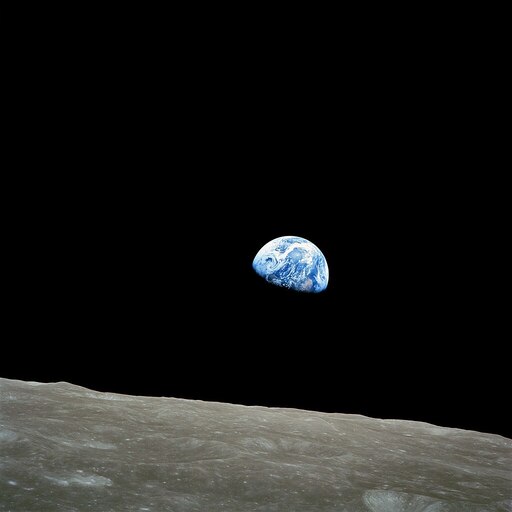Why Are We Going to the Moon… Again?

By Kaizad Raimalwala | May 2024
Amid the chaotic turmoil of global geopolitical conflicts that typically occupy mainstream news, one may have recently heard about several spacecraft launching to the Moon in the last few years; this came after a relatively quiet period that followed the flurry of the 60s/70s Space Race. Nations such as China, Japan, India, and the UAE are flying to the Moon, but now even private companies are en route in a new wave of commercial exploration. What’s the sudden interest? Is there actually money to be made? Didn’t we already go to the Moon in the 60s? What’s the point of any of this?
The Moon has always captured my eye, and I am not alone. A harsh but starkly beautiful landscape with light and shadow in an eternally cyclical dance, the Moon is the crown jewel of our night sky and even at less than half a million kilometers away it presents an important reminder for anyone who simply looks up at the sky: we have a long way to go in exploring our universe. There is no doubt about the innate flicker in the human condition that leads us down paths unknown in the quest for knowledge. Going to the Moon — and then beyond — is just one seemingly simple manifestation of this human phenomenon.
In the cold war era, the Moon transfixed two superpowers in a race to plant a flag and show their supremacy in technology and exploration. In the decades that followed, the Moon became a lonely and forgotten place, but this is rapidly changing. The Moon is – for lack of a better word – popular again.
Since the 50s, space programs have been the domain of superpower governments, and rightly so, as no other organization would be able to justify the risk and cost for minimal returns.
And yet, we’ve hit a ceiling of what a superpower government can do on their own. Even with less than 0.5% of the US federal budget[1], NASA has managed to accomplish significant feats, from sending probes to the far reaches of our solar system, to sending autonomous rovers to Mars hunting for signs of life, to establishing a routinely occupied space station in Earth orbit for cutting edge R&D. But it is not enough. It is not enough to fully drive forward humanity into space. For millions of human beings to live and work and move beyond, it is imperative that we steadily extend our economic sphere of activity to the Moon. It is the economic activity between public and private organizations sharing the risk and reward that will make spaceflight sustainable.
(For the valid questions:
- Why do we go to space at all?
- Can all this money and effort be used to solve the world’s problems?
I refer you to several others who have written about their thoughts[2],[3])
In 2009, following the crash of financial markets that led to the biggest post-WW2 global recession, there was also a quiet and deliberate crash on the Moon’s surface that would have ripple effects in the years to come for the space economy. A stellar team of scientists and engineers as part of NASA’s LCROSS (Lunar Crater Observation and Sensing Satellite) mission had made a significant discovery: that water exists on the Moon. “And we didn’t find just a little bit, we found a significant amount,”[4] Bingo!
Water Water Everywhere
Water is widely regarded as one of the critical commodities that we will need out there in the far reaches of space. It may even be said that one cannot live without water, though I personally would not like to test this hypothesis.
For spaceflight companies, beyond the need for water to make morning espresso for their engineers, a key step to meeting quarterly targets, they also highly value water as it can be broken down into hydrogen and oxygen which can then be used as rocket fuel. By directly sourcing water on the Moon, we can not only use that water for human presence, but companies mining this water can also sell rocket fuel to interested buyers. This recent announcement[5] is an early sign of this emerging commercial market to make use of lunar-sourced rocket fuel for refueling satellites orbiting the Earth.
So this discovery in 2009 was a key milestone in this effort as companies have since been revving up to go to the Moon with ambitious business plans.
NASA taking a back seat on the way to the Moon
Commercial spaceflight, i.e. when for-profit companies fly to space as a core part of their business model, is not a new phenomenon. Private companies have been flying satellites to Earth orbit since the dawn of the space age, to enable telecommunications, GPS, weather monitoring, and other activities that have a viable business case. In fact, vast majority of the space economy is intended to serve us on Earth and improve our livelihood. It is a relatively small fraction that is being spent on scientific research, development, and exploration. It is in these domains of science and exploration where government superpowers have played a leading role until the turn of the 21st century, due to the inherent high risk and lack of reward involved.
In 2004, Virgin Galactic became the first for-profit company to fly an astronaut to space, as it led the charge to win a $10M prize set out by the X Prize Foundation (no relation to the current X or Elon Musk). Spaceflight engineering is incredibly hard, and for a private company to accomplish this was an incredible feat. It should be noted that while commercial aviation is routine today, in the early 20th century it was not so dissimilar to where spaceflight is today. Indeed, the X Prize was inspired by the Orteig Prize from 1919: $25,000 offered to any aviator to fly non-stop from New York to Paris, which was ultimately won by Charles Lindbergh in 1927 after multiple attempts and multiple fatalities.
Back to the Moon: in 2007, Google announced an audacious prize of $20M to any privately funded organization who could fly a rover to the Moon and send back high-definition images. Even though this prize was left largely unclaimed by 2015, it spurred a new generation of startups that surfed this new wave of commercial lunar exploration. Where Google left off, NASA picked things up at the right time and made a game-changing announcement in 2018. NASA had committed to going back to the Moon as part of a long-term journey to Mars and beyond, but this time they will also hail a ride from a new cohort of space cabbies who would compete to get them to the Moon at a lower price point than what NASA would typically spend on their own. Called the Commercial Lunar Payload Services (CLPS) program, NASA committed $2.9B over 10 years to be an anchor customer for these companies to fly NASA-funded science experiments and help kick-start a new industry for lunar and space transportation and logistics.
Going to Space is Hard, Landing on the Moon is Harder
There have now been multiple attempts to go to the Moon that have been led by for-profit companies, not nation funded agencies, and there are many more to come. There has yet to be a fully successful attempt to land a spacecraft gently on the Moon, and stay upright, but as some say, space is hard, and the industry is learning quickly. What matters is that because of the creation of this new industry, companies now offer flights to the Moon at rates of around $1M / kg of payload. This has opened up doors to organizations around the world to afford lunar exploration and technology demonstration campaigns with limited budgets. Major spacefaring nations such as USA, China, Japan and India continue to fly their missions to the Moon in the old-fashioned way because they can afford to do so. But now, other countries such as Mexico, Canada and Australia are joining them through this new “low-budget” taxi service, and many more countries (Poland and Turkey for example) are drawing up plans to take advantage of this. Dubai’s very own Mohammed Bin Rashed Space Centre (MBRSC) has been at the forefront of this model, flying a rover to the Moon as part of their Emirates Lunar Mission[6] to continue to demonstrate their spaceflight capabilities and contribute to the body of scientific knowledge.
In the near term, NASA will continue to play the role of an anchor customer and catalyst for the commercial sector to mature their offerings. Through their Artemis program, NASA is focusing its efforts on enabling permanent settlement on the lunar surface to support scientific investigations and facilitate a proving ground for technologies needed for missions to Mars and beyond. NASA is leveraging international partners for this – Canadian and Japanese astronauts will be flying to the Moon alongside NASA astronauts on their first crewed missions. But success is contingent on also procuring a wide range of commercial services. Much of the private sector involved in supporting these lunar missions hopes to be able to extract resources from the dirt on the Moon and produce economic goods that can be used to support and sustain life and other activities in space, and reduce what humans need to bring from Earth. In the next few decades we will see a fascinating array of missions to bring to reality what we typically see in science fiction: specialized mining vehicles harvesting lunar dirt, robotic vehicles constructing roads for regular transport and landing pads for rockets to take off from the lunar surface, 3D printing of structures and eventually habitats, experiments to grow plants on the Moon, machines producing oxygen and water, deployment of small nuclear reactors, and many more. Even entertainment and tourism companies are looking to make use of this new commercial lunar spaceflight paradigm: movie production companies are footing the bill to fly high-definition 360° VR cameras so they can offer incredible immersive experiences of what it’s like to be on the lunar surface[7].
Taking off my rose-tinted space goggles, I will say that a lot of things have to go right in the many years to come, including continued government investment to play a lead exploration role, and for water to actually be on the Moon in appreciable and extractable amounts, for many of these business models to be viable and sustainable. Nonetheless, we would not be who we are a species if we did not try. It is my opinion that raising our economic sphere of activity over and beyond Earth is the only way to make space exploration sustainable.
Moving Forward, Looking Back
However far we go forward, we cannot forget our home. The photograph in the article is called Earthrise[8], taken by William Anders in 1968, one of three human beings to be the first to get this close to our Moon and orbit it. It is a testament to how unfathomable the scale of space and time is, that this only happened 56 years ago, in a world where our species came online 300,000 years ago, in a world that was born over 4 billion years ago. It was just a moment ago when someone went so far from home they could cover our planet with their little thumb – the whole planet that’s been home to all things we love. Earthrise is indeed known as the most influential environmental photograph taken and helped kickstart the modern environmental movement to be better about how we treat our home. I hope hundreds or thousands or maybe millions of people can go to the Moon in our lifetime, if only to look back and see where we come from.
[1] https://www.planetary.org/space-policy/nasa-budget
[2] https://time.com/5953877/spend-more-on-space-travel/
[3] https://www.planetary.org/articles/space-exploration-is-always-worthwhile
[4] https://www.space.com/7530-significant-amount-water-moon.html








